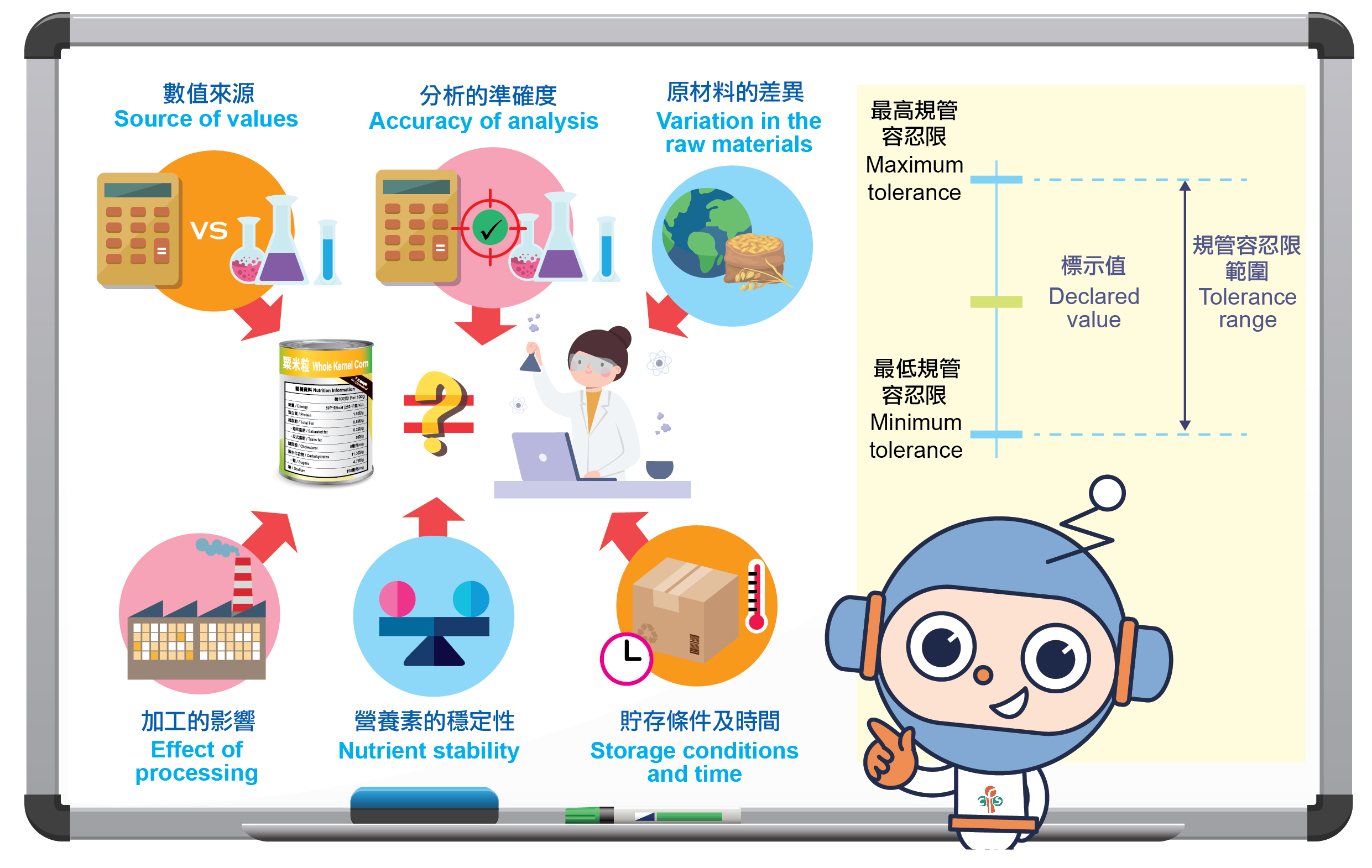
Food Safety Focus (184th Issue, November 2021) – Article 2
Making Reliable Food Nutrition Labels
Reported by Dr. Violette LIN, Scientific Officer
Risk Assessment Section, Centre for Food Safety
As discussed in our last article, nutrition labelling provided on foods allows consumers to make informed, healthier dietary choices. The provision of nutrition information can promote public health, such as making healthier food choices and preventing non-communicable diseases. The declared nutritive values are usually derived either directly from manufacturer's analysis of the food, or indirectly from calculations from food composition data.
Food is a difficult matrix and there are a number of reasons why the declared value of a nutrient might not match exactly with values of a specific sample of the food tested by the laboratory. The variations in seasons, processing practices, ingredient sources, nutrient stability and storage conditions (Figure 2) may result in discrepancies in the nutrient values among the same product of different batches and even within the same batch. That said, the nutrient contents of foods should not deviate substantially from the labelled values, and tolerances set for nutrition labelling are therefore important benchmarks for the trade to follow.
The Codex's Guidelines on Nutrition Labelling have provided some general principles for setting of tolerance limits for declaring nutrition information on food labels. Hong Kong made reference to these principles as well as the approaches practised in some jurisdictions such as mainland China, Singapore and the United States, establishing tolerance limits for various nutrients, and the tolerance limits were specified in the technical guidance notes for general prepackaged foods and infants and young children (IYC) formulae and foods.
Measurement uncertainty of testing, on the other hand, relates to the range of possible measured values which the true value of the measurement falls within. For example, a certain nutrient of a food item was measured to be 10.0mg/100g by testing, but multiple factors, such as sample homogeneity, precision of instrument, testing methods and environment, can affect the accuracy of the measurement result. This uncertainty gives a plausible range, say from 8.5mg/100g to 11.5mg/100g, within which the true value of that nutrient might actually be. Since measurement uncertainty was not considered when establishing corresponding tolerance limits, the measurement uncertainty of testing is commonly taken into account upon compliance checking.
Labelling of Negligible Amounts of Nutrients
Internationally, it is common to regard insignificant amounts of nutrients as negligible, which can therefore be declared as "zero". However, the definition of "zero" for different nutrients varies among different jurisdictions. Take trans fat as an example. If a food product contains 0.5g or less per serving, it can be declared as "0g" on a nutrition label in the United States, whereas locally, in contrast, it defines "zero" for trans fat at 0.3g or less per 100g of food.
Traders should be careful when declaring zero for certain nutrients. For example, there can still be sugar from the primary ingredients of a prepackaged food with no free sugar added. For the sake of compliance, traders should make reference to the technical guidance notes published by the Centre for Food Safety (CFS) on the definition for different nutrients applicable to locally available food.
Compliance Checking and Communication with the Trade on Nutrition Labels
In Hong Kong, the regulations related to nutrition labelling are stipulated under the Food and Drugs (Composition and Labelling) Regulations (Cap. 132W). The CFS has initiated a surveillance system for nutrition labelling. From 2018 to 2020, more than 21,000 inspections of labels were conducted and 1,500 samples were tested, with unsatisfactory rates of 0.45% and 6.2% respectively. The 98 samples with unsatisfactory testing results involved nutrient discrepancies in energy, protein, fat, carbohydrates, sugars and sodium. In this connection, the CFS has instructed traders to take remedial actions, including temporary cease of selling the affected prepackaged food products until the rectification of irregularities on the nutrition labels.
Given the possible variations of nutrient contents within the same product batch, as endorsed by the Expert Committee on Food Safety of the CFS, it is recommended to take 12 samples from the same batch as far as practicable in sampling. Overseas jurisdictions such as Canada also have similar recommendations that several samples should be collected for nutrition label testing. On communication with the food sector, the CFS conducts regular technical meetings and workshops to facilitate traders’ compliance. The public can now access a designated website of the CFS as a resource hub for nutrition labelling, with practical guidelines on preparing legible labels, determining serving size, making nutrition claims, and seeking accredited laboratories in and outside Hong Kong.
In summary, food traders are advised to ensure that the information provided in the nutrition label is truthful. For more detailed information on declaring nutrition information, traders are suggested to refer to the CFS' technical guidance notes for general prepackaged foods and IYC formulae and foods.
Figure 2: Factors leading to discrepancies between the declared nutritive values and the values tested by laboratory (left), and an example illustrating the tolerance limits (right)



